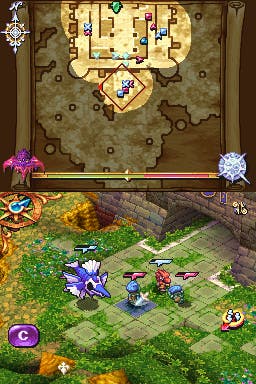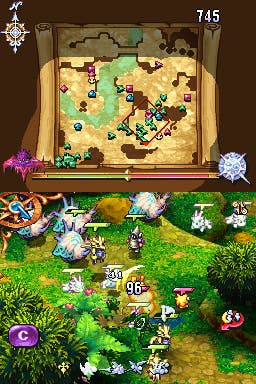Heroes of Mana
Hero to zero?
You have to feel a little sorry for fans of the Super Nintendo's Secret of Mana, a videogame that constantly makes the All Time Top 100 lists for its seminal offline multiplayer adventuring experience. Almost every sequel and spin-off since its release in 1993 has been an abject disappointment, critically panned (or at least met with muted praise, which, in many videogame publications amounts to much the same thing) and shunned by players. Not only that but fans have had to put up with also almost every review of these sorry sequels opening in much the same way: reminiscing about the good old days.
Um, sorry.
Like the equally directionless and, mercifully, currently defunct ‘Saga' series, Square-Enix has used the ‘Mana' name, universe and framework to try out creative but mostly unsuccessful new ideas for the genre. It's a commendable enterprise that has certainly helped distinguish the series from the identikit JRPG throng, but has so far failed produce anything approaching another good videogame.
This has been a constant source of consternation for fans of the SNES title(s), none of whom can understand why the company wouldn't just build upon its firm but neglected foundations. Players hoping that this latest title in the Seiken Densetsu (as it's known in Japan) lineage might reattach itself to those esteemed roots are in for more grief: Heroes of Mana is now a PC-style Real Time Strategy game, albeit clothed in the characters and cutesy 2D sprite work that brings at least some superficial coherency to the Mana universe.

But before anyone gets the chance to assess this brave new direction for the series, they'll need to negotiate some protracted introductory narrative scene-setting. Adding further weight to the groaning shelf of evidence that videogame designers know little of how to skillfully introduce their characters and stories to players, you must tap your way through several long, clunky conversations and cutscenes before anything gets properly interactive. This is something you'll need to get used to as lingering intrusions continue throughout the game with far too much frequency, a constant but unnecessary reminder of its RPG lineage that detracts from, rather than adds to the experience.
When you actually do get your hands on a cursor, the RTS mechanics are both robust and comfortingly familiar to anyone who has played Command and Conquer, et al. Your spaceship (which has crashed to earth) functions as the base unit from which you can produce various types of units to collect resources and do battle in your name.
Unlike with traditional RTS games, the structures that you build are housed within your base rather than being placed on the map. Once you have collected sufficient resources you enter your spacecraft, select the facility you wish to purchase and it will be added to the ship's interior. A wide range of units can be created from these facilities and one by one your army begins to grow in range and breadth. There are four types of combat unit available (Heavy, Ground, Missile and Flying) and a great many different species of monster that represents each.
A slightly more complex version of scissor, paper, stone dictates which of the four types is more effective in a skirmish, with Heavy Unit strong against Ground Units but vulnerable to Flying Units, and so on. It's possible to have up to 25 combat units on the battlefield at any one time - an impressive feat but one that ultimately leads to the game's downfall.

The controls of the game are excellent, allowing you to tap individual units or circle multiple units to select them, before directing them to your preferred destination by simply touching the screen in the appropriate place. With the dpad you can freeform scroll around the environment, and thus send units toddling off across wide spaces without any bother. It's fast, easy and intuitive and, as its possible to swap the top and bottom screens with the touch of a button (allowing you to quickly switch between menus and action) it's all very manageable.
However, the path-finding AI that Square has invented for its units is an unmitigated disaster. As the map is divided into a hidden grid system, your units work their way over to the destination you've tapped - but not in a straight line as the crow flies, but rather along a convoluted path that's calculated by which spaces in the grid are free at the moment the command is issued. This works when an environment is empty, but add a few units in and it becomes Benny Hill-style mayhem. Worse, the AI will frequently send your units off deep into enemy territory simply because a set of squares in the direct path was occupied by another friendly unit.
Likewise, there are few things more excruciating than watching a small group of units failing to negotiate a simple ramp or bridge simply because they keep getting in each other's way. Newly created units automatically gather around the base until they are issued their first order. As soon as you have just a few units loitering outside the base, your resource gathers will suddenly be unable to drop their harvest, and this brings your whole flow of industry to a grinding halt. As units are incredibly slow at moving around - as well as being incompetent at it - the game's pace feels broken, especially since levels shouldn't actually take very long to complete at all.
These problems are, of course, all sugar coated by Square-Enix's fantastic presentation and artwork. Menus are slick and easy to navigate, sprites and environments are rich and colourful, and the anime cutscenes add yet more sheen and class to the package. But despite all of the positives, the game underneath, for all its features and ideas, remains a broken one, thus continuing the Mana series legacy of being a series that tries its hand at new things to get noticed, but one which fails to match up to the brilliance of its forefather.

